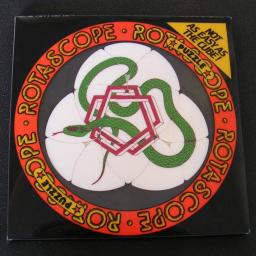


The Rotascope puzzle consists of three intersecting discs. As such it is similar to Trio, and the two-disc puzzles Turnstile and Rashkey. Unlike those puzzles however, the pieces are shaped so that they often prevent a disk from being moved. It can be considered a bandaged puzzle, closely related to the Bandaged cube, which was also invented by Raoul Raba. Raba named the puzzle Taquinoscope, but when it was manufactured by Pentangle it was given the name Rotascope. Below I reproduce the writing on the back of the packaging.
Object: To restore the original picture by rotating the 3 circles through 1/6th turns. Ensure that the circles are accurately aligned and do not use force.
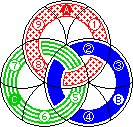
Hint: The ROTASCOPE is constructed from 13 curvilinear triangles (1 heart, 3 points and 9 shield-shaped pieces). The 'points' can never leave the circle they start in and the heart must be in the circle which you want to turn. Thus for example, if you start from figure one and rotate circle 'B' clockwise 1/6th turn, the only logical move that you can then make is to move circle 'A' 1/6th turn clockwise.
In 1873 Sam Lloyd invented the 15's Puzzle and started an international craze for the simple sliding squares puzzle. 109 years later these puzzles are still for sale in nearly every toyshop in the world.
In 1975 Erno Rubik invented the Magic Cube. Pentangle launched the puzzle on the unsuspecting Western world in 1979 seeding the craze of all time.
Pentangle is now proud to bring you the Rotascope which is a great puzzle combining the simplicity of Sam Lloyd's Fifteens puzzle with the complexity of Rubik's Cube. The Rotascope was invented and patented by Raoul Raba,
Pentangle, Wallop, Hampshire, England.
© Copyright 1977 Pentangle. Registered Design No. 1002813. Patents applied for.
Trespassers will be prosecuted.
(Algorithm & solution available from Pentangle if request accompanied by Certificate of insanity and Prescription Fee.)
Note that the name should actually be Samuel Loyd (not Lloyd), and that there seems to be no hard evidence of the 1873 date of the Fifteen puzzle. Raoul Henrique Raba first applied for a patent for the Rotascope on 10 October 1977 ( FR 2,405,077), well before the cube craze started. You can see images of this patent on Raoul Raba's homepage. His further patents to the Rotascope and some related puzzles are FR 2,463,632 (27-02-1981), FR 2,489,164 (05-03-1982), and FR 2,490,102 (19-03-1982).
The puzzle is two-sided. One side always shows a picture of three interlocking rings (Borromean rings, shown above), but the design of the other side varies. Mine has the Pentangle logo with a snake winding around it. The round black frame also has a small Pentangle logo, with 'Copyright 1980' on it.
If your browser supports JavaScript, then you can play Rotascope by clicking the link below:
To see why this is a 'bandaged' puzzle, examine the two pictures below. On the left is the non-bandaged version, where every disc can always move 1/6th of a turn in either direction. On the right is the initial configuration of the Rotascope. Each piece has essentially been formed by fusing several pieces of the unbandaged puzzle.
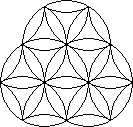
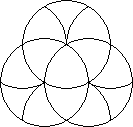
The puzzle is somewhat difficult because moves are very often blocked. Because of this, the possible positions do not mathematically form a group. Nearly all other moving piece puzzles do form groups because they are in effect (isomorphic to subgroups of) permutation groups, usually generated by the simplest possible moves. On this puzzle not every move is possible at every moment so the face turns cannot be considered generators of a group. See the Useful Mathematics page.
By computer search I examined how many configurations there are if we only look at the piece shapes, and ignore the printed pattern. It turns out there are 502 configurations, though only 49 have the 'heart' piece in the centre. The results are shown in the table below. It shows how many configurations there are for each number of disc turns from start versus number of 1/6th turns from start.
| Disc turns | |||||||||||
|---|---|---|---|---|---|---|---|---|---|---|---|
| 1 / 6 t h t u r n s |
0 | 1 | 2 | 3 | 4 | 5 | 6 | 7 | 8 | Total | |
| 0 | 1 | 1 | |||||||||
| 1 | 6 | 6 | |||||||||
| 2 | 6 | 12 | 18 | ||||||||
| 3 | 3 | 12 | 24 | 39 | |||||||
| 4 | 6 | 36 | 36 | 78 | |||||||
| 5 | 24 | 39 | 18 | 81 | |||||||
| 6 | 6 | 18 | 30 | 30 | 84 | ||||||
| 7 | 21 | 36 | 24 | 81 | |||||||
| 8 | 6 | 18 | 24 | 18 | 66 | ||||||
| 9 | 12 | 24 | 36 | ||||||||
| 10 | 12 | 12 | |||||||||
| Total | 1 | 15 | 30 | 90 | 93 | 75 | 84 | 60 | 54 | 502 | |
The table shows that it takes at most 8 moves to get to the same configuration as the solved position (i.e. 'heart' in the centre, 'points' at outermost position of each disc). Once in this configuration only the nine 'shield' pieces need to be swapped about in order to solve it.
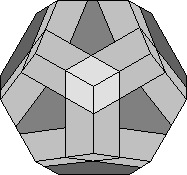
Once in a given configuration, the positions in such a configuration do form a (permutation) group. It is generated by the application of move sequences that return the puzzle to the same configuration. It turns out that only even permutations of the shield pieces can occur. The reason is quite subtle: Note that for a face to move, it must contain the heart piece. Any sequence of moves that permutes the pieces and brings them back to the same configuration must have an even number of 1/6th turns to bring the heart back to its original position. Therefore it must be an even permutation of the other pieces, and in particular an even permutation on the shield pieces. This exact same reasoning is used in the Bandaged cube.
The reason it is so similar to the Bandaged cube is that the Rotascope is a kind of bandaged Megaminx as shown on the right. The number of configurations is not exactly the same because the megaminx has fivefold rotations, but if the Rotascope configurations that have a 'Point' piece in the centre are discounted, the two puzzles become identical.
I have calculated God's Algorithm for this puzzle. It turns out that it can be solved in at most 36 turns, or 44 moves if every sixth of a rotation counts as a move.
| Disc Turns | Sixth Turns | |||||||||||||||||||||||||||||||||||||||||||||||||||||||||||||||||||||||||||||||||||||||||||||||||||||||||||||||||||||||||||||||||||||||||||||||||||||||||||||||||||||||||||||||||||||||||
|---|---|---|---|---|---|---|---|---|---|---|---|---|---|---|---|---|---|---|---|---|---|---|---|---|---|---|---|---|---|---|---|---|---|---|---|---|---|---|---|---|---|---|---|---|---|---|---|---|---|---|---|---|---|---|---|---|---|---|---|---|---|---|---|---|---|---|---|---|---|---|---|---|---|---|---|---|---|---|---|---|---|---|---|---|---|---|---|---|---|---|---|---|---|---|---|---|---|---|---|---|---|---|---|---|---|---|---|---|---|---|---|---|---|---|---|---|---|---|---|---|---|---|---|---|---|---|---|---|---|---|---|---|---|---|---|---|---|---|---|---|---|---|---|---|---|---|---|---|---|---|---|---|---|---|---|---|---|---|---|---|---|---|---|---|---|---|---|---|---|---|---|---|---|---|---|---|---|---|---|---|---|---|---|---|---|---|
|
|
|
|
| ||||||||||||||||||||||||||||||||||||||||||||||||||||||||||||||||||||||||||||||||||||||||||||||||||||||||||||||||||||||||||||||||||||||||||||||||||||||||||||||||||||||||||||||||||||||

Hold the puzzle with the rings design at the front. The three 'point' pieces are marked A, B, and C. As these pieces can never leave the disc they started in, this also marks the three discs as A, B, and C. Hold the puzzle so that disc A is at the top. A clockwise 1/6th turn of a disc is denoted by the appropriate letter (A, B, or C) and an anti-clockwise turn by the letter with an apostrophe (i.e. A', B' or C'). The shield pieces are marked 1-9, so I will use the same numbering in the solution.
Phase 1: Bring the puzzle into the right configuration
The rest of this solution is mostly just a list of move sequences, one sequence for each possible way each piece needs to move. I found these sequences by a computer search, and while there are too many for the solution to be really suitable for memorisation, it is relatively fast.
Phase 2: Solve piece 8.
Phase 3: Solve piece 9.
Phase 4: Solve piece 1.
Phase 5: Solve piece 2.
Phase 6: Solve piece 3.
Phase 7: Solve piece 4.
Phase 8: Solve piece 5.